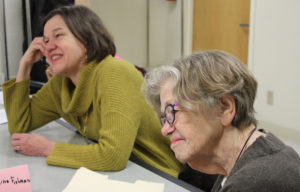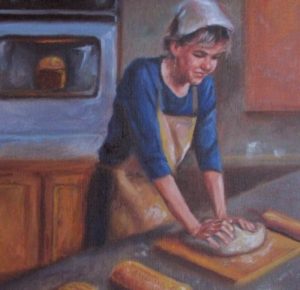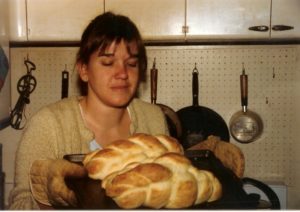Benefits of Teaching Memoir: They Span Generations
December 20, 2018 • 15 Comments • Posted in memoir writing, teaching memoirAward-winning writer Elly Fishman contacted me from her Montreal home a few months ago. A magazine editor in Chicago before moving to Canada, Elly is freelancing now. She had an idea for a story that would require some research in Chicago. Could she visit her grandmother’s memoir-writing class while she was in town?

That’s Elaine Fishman in our class at the Chicago Cultural Center. Photo by Darlene Schweitzer.
Thoughtful, playful, and humble, Elly’s grandmother, Elaine Fishman, has a kindness that immediately makes you feel like you’ve been friends for years. I told Elly I’d have to ask the class first. “I’m sure they’ll approve.” They did.
Elly sat quietly during her visit, listening intently to every essay she heard. Until she thanked us all at the end, I’d forgotten she was there.
My Grandmother’s Chicago, Elly’s beautiful story about her love for her grandmother and the tales she tells of a long-gone Chicago, was published in Chicago Magazine this month. Reading it leaves me with that wonderful feeling, you know, where you want to smile and cry at the same time. Here’s how it starts:
Three years ago, at the age of 87, my grandmother Elaine Fishman decided to take a memoir-writing class. She’d always been an avid reader, but who knew she was also a prolific writer? Since starting the class, she’s written dozens of stories — usually vignettes of just a few paragraphs — chronicling her long life, which began in Albany Park in the 1920s, back when there were still people around who remembered the Great Chicago Fire. Reading her anecdotes, I’ve learned a lot about the origins of my family, going back to my grandmother’s parents, Russian Jews who immigrated at the turn of the 20th century, and their parents too. More than that, though, I’ve been able to gaze across the years at a younger Chicago, one that sounds a lot more like the Old World than the New.
In “My Grandmother’s Chicago,” Elly creates a double-memoir of sorts. She gives readers bits and pieces of her own story, sprinkles in excerpts of Elaine’s essays, and lets us in on what her grandma’s written stories teach her. When introducing an excerpt of Elaine’s essay about a memorable long ago walk with her father, for example, Elly points out “Grandma’s stories depict a city where life happened on sidewalks and stoops, not on smartphones, and simple things like a walk to a faraway neighborhood counted as a big deal.” After that intro comes this excerpt from the 500-word essay her Grandma wrote for class:
My father grew up in a family of seven sisters, who all lived in Rogers Park. One lovely summer day, my father asked me to join him on a walk to visit them. When I started to tire and complain, he urged me on, saying we were coming to a famous taffy apple shop. Shoemaker’s, what heaven! The day grew warmer and I was thirsty. We stopped in a bar. There was sawdust on the floor and a bowl of hard-boiled eggs on the counter. My father had a beer and the bartender gave me a Coke. My aunts could not believe that my father and I had walked all that way, but for me, walking hand in hand with my father is one of my happiest memories.
Elly writes that some of her grandmother’s best writing is about the lifelong love affair with her husband, Elly’s “Papa Guy.” I have to agree. The ones Elly singles out in the article are class favorites, both of them taking place when her grandparents were still courting — Elaine dancing with Guy in her parents’ kitchen while dressed in magenta taffeta pajamas, and the letters her young GI sent her while overseas during WWII. “He was a gifted artist and adorned the envelopes with drawings,” Elly writes about her beloved Papa Guy. “Eventually, the postman knew where to deliver the letters without having to look at the address.”
Elaine married young, just after Guy returned from World War II. Elly met her own husband, Jonah, when she was just 22. “At the time, my mother worried I’d met him too soon,” Elly writes. “My grandmother never thought so.” Elly began her wedding day with her grandma, spending the morning at Elaine’s Chicago apartment. Before they left for the wedding, Elaine slipped her granddaughter a folded sheet of paper: Elaine had written a story about her own wedding, entitled “No Regrets,” especially for Elly.
“Now, a year into my own marriage, as my husband and I continue to navigate our newly entwined lives, I unfold that piece of paper sometimes,” Elly says to end her article. “Like all of Grandma’s stories, it makes me feel the past is something worth holding on to.”


